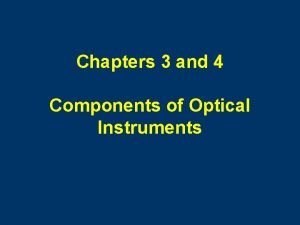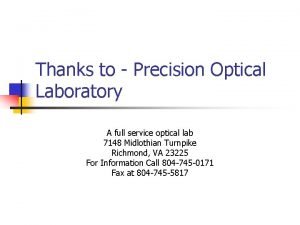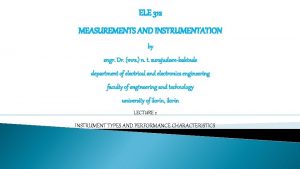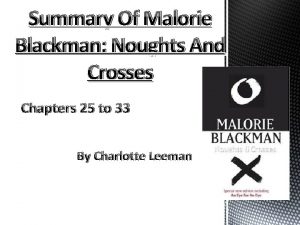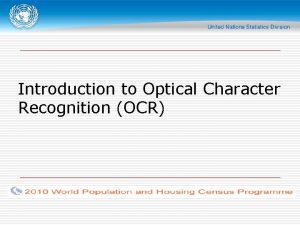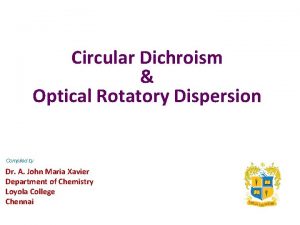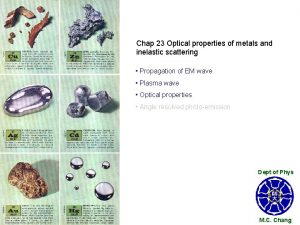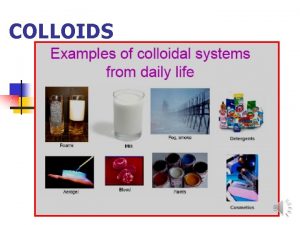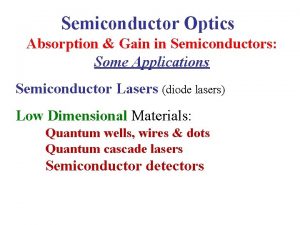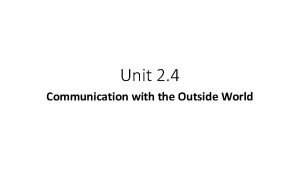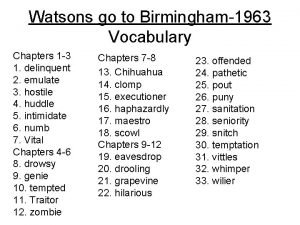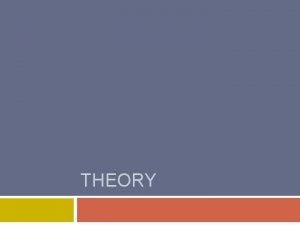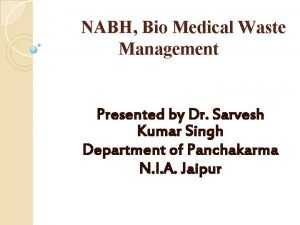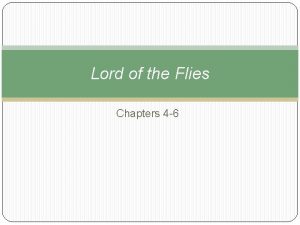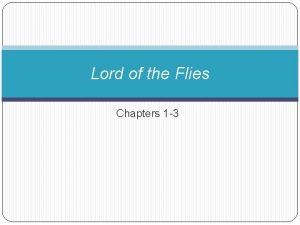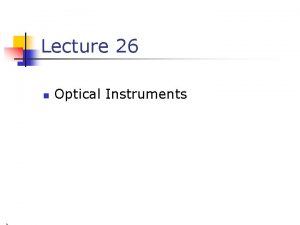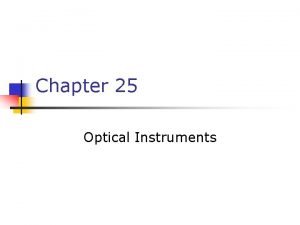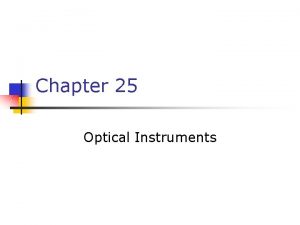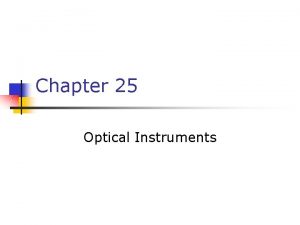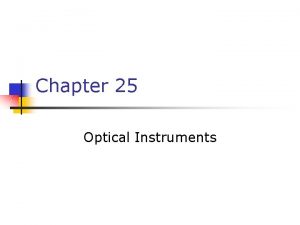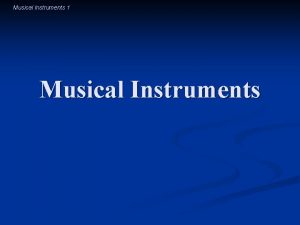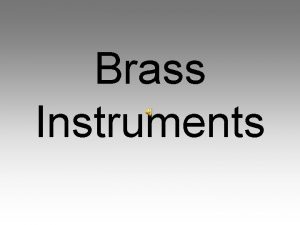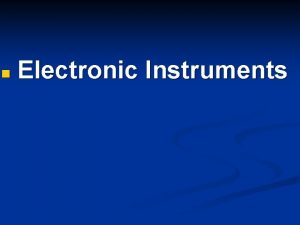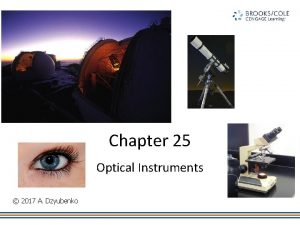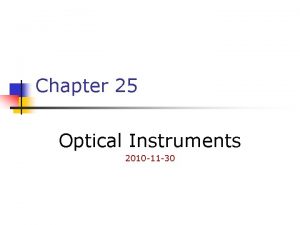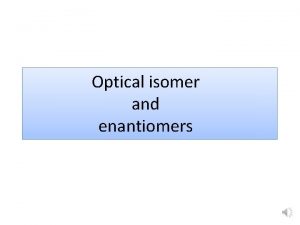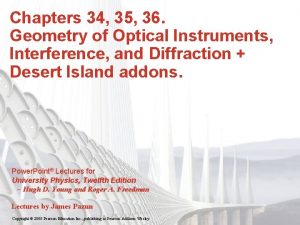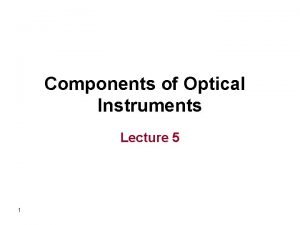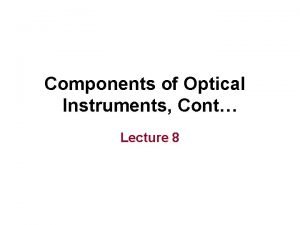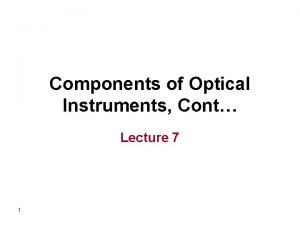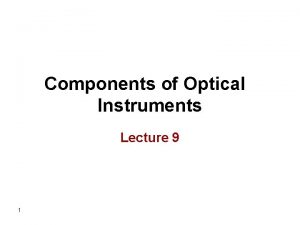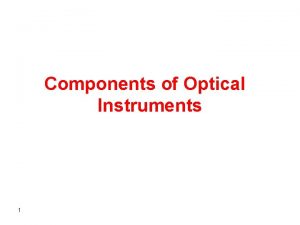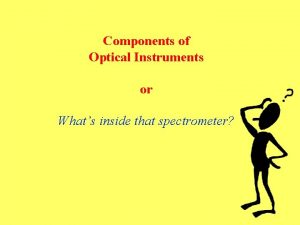Chapters 3 and 4 Components of Optical Instruments






























































- Slides: 62

Chapters 3 and 4 Components of Optical Instruments

Components of optical instruments Absorption 2. 3. Fluorescence Emission 1. and chemiluminescence phosphorescence Source Wavelength Selector Sample l Rgb back 146, 184. 148 Detector Readout 8888

Construction Materials for Spectroscopic Instruments Wavelength 100 Region VUV 180 UV 380 850 Visible 2000 18000 Near IR IR Li. F Fused silica or quartz Materials for cells, windows, lenses and prisms Corex glass Silica glass Na. Cl KBr Tl. Br or Tl. I Zn. Se 40000 Far IR

Sources for Spectroscopic Instruments Wavelength 100 180 380 Region Sources 850 2000 VAC UV Visible Near IR 18000 IR Ar lamp Xe lamp H 2 or D 2 lamp Tungtstan lamp Continous Nernst glower Zn. O 2+Y 2 O 3 Nichrome wire Glowbar Si. C Line Hollow cathode lamp Lasers 40000 Far IR

Wavelength Selectors for Spectroscopic Instruments Wavelength 100 Region Wavelength selectors VAC 180 380 UV 850 Visible 2000 18000 Near IR IR Far IR Fluorite prism Fused silica or quartz prism Glass prism Continous Na. Cl prism KBr prism 3000 lines/mm Grating 50 lines/mm Interference wedge Discontinous Interference filter Glass filter 40000

Detectors for Spectroscopic Instruments Wavelength 100 180 380 Region Detectors 850 2000 VAC UV Visible Near IR 18000 IR 40000 Far IR Photographic plates Photomultiplier tube Photo tubes Photoelectric Photo cells Photo diodes Charge coupled devices Photo conductors Thermocouples or bolometers Thermal Golay pneumatic cell Pyroelectric cell

Light Amplification by Stimulated Emission of Radiation LASER • Characteristics of a laser: – Spatially narrow and intense – Highly monochromatic – Coherence

Schematic of a Laser Source Nonparallel radiation Active lasing medium Mirror Laser radiation Partially transmitting mirror Radiation Pumping source Power supply

Processes in Laser Action 1 - Pumping Excitation 2 Spontaneous by electrical, emission radiant or chemical energy 3 - Stimulated emission 4 - Absorption Ey’’’ Ey’ Ey Ex Metastable Excited state

Processes in Laser Action 1 - Pumping Excitation 2 Spontaneous by electrical, emission radiant or chemical energy 3 - Stimulated emission 4 - Absorption Ey’’’ Ey’ Ey Ex Metastable Excited state

Light attenuation by absorption Noninverted population Light amplification by stimulated emission Inverted population

E 1 Ey Ey Ex E 0 Three level system Four level system

Conduction band Valence band Conductor Valence band Semiconductor Insulator

p-metal Emitted radiation 3 mm strip width n- type Ga. As substrate n-metal Fig. 7. 9

974 nm laser 450 nm laser Nonlinear crystal Laser diode Fig. 7. 10 Blue-green output

Wavelength Selectors • Filters – Interference – Absorption • Gratings • Prisms

Interference Filters Glass plate Metal film Dielectric layer Metal film Glass plate

Interference Filters q Metal film Dielectric layer t Metal film Condition for reinforcement If q < 10 o nl’ =2 t l= l’h l = 2 th/n nl’ =2 t/cos q

Wedge Type Interference Filters Glass plate Metal film Dielectric layer Metal film Glass plate l 1 l 2

Transmission Characteristic of Interference Filters 100 Effective bandwidth= 15 A Percent Transmittance 80 Effective bandwidth= 15 A 60 40 20 0 5090 Effective bandwidth= 10 A 1/2 Peak height 5110 6215 6225 Wavelength 6940 6960

Effective Bandwidth of Filters 100 Interference Filter Percent Transmittance 80 60 Effective bandwidth=10 nm 40 Absorption Filter 20 Effective bandwidth= 50 nm 0 40 450 500 550

Coupling of Filters 100 Percent Transmittance Orange cut-off filter Green filter 50 Combination of two filters 0 400 500 Wavelength nm 600 700

Czerny Turner Grating Monochromator Concave mirrors Reflection grating Entrance slit Focal plane l 1 l 2 Exit slit

Bunsen Prism Monochromator Entrance slit l 1 Collimating lens Prism Focusing lens l 2 Focal plane Exit slit

Dispersion by a Prism a i r r b Quartz cornu Littrow Mirror

or t c e t De So ur ce Diffracted beams at refelected angle r Monochromatic beams at incident angle i d* sin i + d sin r = l n=1 r d*sin i d*sin r i d

or Diffracted beams at refelected angle r So ur ce ct Dete d*sin i d*sin r d* sin i + d *sin r = 1. 5 * l Monochromatic beams at incident angle i r d*sin i i d*sin r d

Photolithography UV lamp Mask Photoresist Plate Developing solution Etching solution

Performance Characteristics of a Grating Monochromator l + l 1 Exit slit

Dispersion of Monochromators 200 300 400 500 600 700 800 nm Grating 200 350 400 450 500 600 800 nm Glass prism 200 nm 250 300 350 400 500 800 Quartz prism cm 0 5 10 15 20 Distance along focal plane 25

Performance Characteristics of a Grating Monochromator

Echelle Monochromator i r r = i = b = 63 o 26’

, gth nm n e vel a W Echelle grating Diffraction order, n 30 Degree prism 260 Diffraction order, n Prism dispersion 108 300 98 88 400 68 48 620 380 500 600 220 280 340 78 58 240 360 480 560 260 300 280 340 320 460 540 420 500 800 480 760 740 720 700 680 660 640 Wavelength, nm Grating dispersion

Illumination of an Exit Slit l 3 l 1 l 2 Power Monochromator Exit slit l 3 l 2 Wavelength l 1 Detector

Power Slit width= 3(l 2 -l 1)/4 (l 2 -l 1)/2 l 2 -l 1 Effective bandwidth l 3 l 2 Wavelength l 1

Effect of Spectral Bandwidth 0. 700 0. 5 nm bandwidth Wavelength, nm (a) 0. 100 275 0. 100 1. 0 nm bandwidth 220 275 Wavelength, nm (b) 0. 600 Absorbance 0. 100 220 Absorbance 0. 600 2. 0 nm bandwidth 220 275 Wavelength, nm (c)

Characteristics of Radiation Transducers 1. High sensitivity 2. High signal to noise ratio Noise 3. Constant response over considerable range of wavelength 4. Fast response time 5. Zero output signal in the absence of illumination Response Signal Power Higher S/N Wavelength Time Power Response 6. The electrical signal would be directly proportional to radiant power S = k. P+kd Lower S/N Power

Types of Radiation Transducers • Photon transducers – UV, Vis, near IR • Heat transducers – IR, far IR

Response of Detectors 1015 Photomultiplier tube Spectral response. 1014 1013 Cd. S photoconductivity cell 1012 Ga. As photovoltaic cell Cd. Se photoconductivity cell Pb. S photoconductivity cell silicon photodiode 1011 1010 109 Se/Se. O photovoltaic cell Thermocouple 200 600 1000 1400 Wavelength nm 1800 Golay 2200

Photon Transducers • • • Photovoltaic Phototube Photomultiplier tubes Photoconductivity transducers Silicon photodiodes Charge-coupled device

Barrier Layer Cell Glass Thin layer of silver Selenium Plastic case Iron + -

Characteristics of Photovoltaic Cells • • Cell current = 10 – 100 m. A No external electrical energy required. Usually used for low level signals. Low internal resistance = amplification not convenient • Fatigue • Low cost

Photoelectric Effect V

Cathode Wire anode 90 Vdc

Sensitivity, m. A/w Response of some Photoemissive Surfaces 80 K/Cs/Sb 60 40 20 200 Ga/As Ag/O/Cs 400 600 800 Wavelength, nm 1000

Dynode Potential(V) Number of electrons 1 90 1 2 180 10 3 270 100 4 360 103 5 450 104 9 6 540 105 Quartz envelope 7 630 106 8 720 107 810 900 V 108 Gain =108 5 7 3 6 4 2 1 8 Anode Grill Photoemissive Cathode 9 Anode 900 V dc Photoemissive Cathode Dynodes 1 -9 Anode + _ To readout

Features of Photomplier Tubes • High sensitivity in UV, Vis, and NIR – Limited by dark current – Cooling to -30 o. C improves response • Extremely fast time response • Limited to measuring low-level signals

Silicon Diode pn junction Metal contact Lead wire p region n region Fig. 7. 30

Silicon diode under Revese Bias Reverse bias Depletion layer

Silicon Diode under Forward Bias Forward bias e e

Reset Start … 10 -Bit shift register Clock + _ … -5 V … Diode number Spectrum Diode number 1 2 … 1024

Start Pulse Clock Pulse 10 -Bit shift register. Photodiode Array Start Clock FET switch Photodiodec onducts Capacitor dischages + _ FETintegrating switch The closes and the capacitor is integrating charged capacitor proportionaly dischages Integrating An output amplfier proportional to the charge is generated. -5 V FET switch closes Diode number Photodiode Diode No. 1 Ohter capacitor The capacitor is charged to charge up charges up value the original 10 p. F Capacitor 2 1024 Read: Irradiation: A start pulse initializes the shift register Charging: Shutter is opened and the and clock pulses sequentially close FET After a start pulse the shift spectrum is focused switches. This charges up on the capacitors At this stage the PDA isthe ready register sequentially closes PAD. thatthe some diodes and into turn charges integrating start. Note the cycle again. FET switches momentarily receive more photons and capacitor proportionaly. The output to charge up the capacitors less. proportional to charge data issome a voltage of the capacitor.

- No. of charges 5 V + - 10 V + - V 12 Electrodes Si. O 2 Insulator n- doped silicon Substrate

Three phase f 1 f 2 clock output f 3 Optical input Metallic electrodes Potential well p type silicon Insulator Si. O 2

Spectrophotometer slit +15 V Thermocouple junction + _ Reference junction To amplifier + _ -15 V

Light path Coating with refractive index n 2 Fiber with refractive index n 1 Refractive index of medium n 3 Numerical aperture=n 3. sinq=sqrt(n 12+n 22) n 1>n 2>n 3 Fig 7. 37

Optical fibers of different lengths 4 Dye laser 5 3 3 × 3 star coupler 6 Monochromator and detection system 2 1 Fluorescence signals Laser excitation Sample 1 Sample 2 Sample 3

1. 0 Fe(I) 0. 8 Fe(I) Ni(I) 0. 6 Ni(I) 0. 4 Cr(I) 0. 2 Cr(II) 0 33250 Fe(I) Fe(II) 33275 Cr(I) Cr(II) 33300 Wavenumber cm-1 Fig. 7. 39 Fe(I) 33325 33350

P(I) F 2 P(n) Frequency domain P(n) Time domain F 1 P(I) P(n) Frequency Fig. 7. 40 F 1 F 2


Movable mirror Beam splitting mirror Source -1 l Fixed Mirror Detector 1 2 3

P(s) P(d) d cm s cm-1 + P(d) P(s) _ d cm + P(d) P(s) _ s cm-1 _ d cm + s cm-1
 Components of optical instruments
Components of optical instruments Components of optical instruments
Components of optical instruments Precision optical instruments laboratory
Precision optical instruments laboratory Active instrument example
Active instrument example Indicating instruments and instruments with a signal output
Indicating instruments and instruments with a signal output To kill a mockingbird 10-11 summary
To kill a mockingbird 10-11 summary To kill a mockingbird chapters summary
To kill a mockingbird chapters summary Noughts and crosses chapter 10 summary
Noughts and crosses chapter 10 summary The great gatsby chapter 4 analysis
The great gatsby chapter 4 analysis Based on chapters 3 and 4 of the strange case
Based on chapters 3 and 4 of the strange case Chapter 18 charlie and the chocolate factory
Chapter 18 charlie and the chocolate factory Summary of chapter 14 to kill a mockingbird
Summary of chapter 14 to kill a mockingbird Scarlet letter chapter 11-12 summary
Scarlet letter chapter 11-12 summary Pride and prejudice chapter 16 summary
Pride and prejudice chapter 16 summary Symbolism in chapter 9 of lord of the flies
Symbolism in chapter 9 of lord of the flies Chapter 21 the scarlet letter
Chapter 21 the scarlet letter Optical mark reader advantages and disadvantages
Optical mark reader advantages and disadvantages Optical fiber disadvantages
Optical fiber disadvantages Circular dichroism and optical rotatory dispersion
Circular dichroism and optical rotatory dispersion Optical properties of metals and nonmetals
Optical properties of metals and nonmetals Tyndall effect
Tyndall effect Optical loss and gain in semiconductors
Optical loss and gain in semiconductors By communicating the outside world
By communicating the outside world Optical switching and networking
Optical switching and networking The watsons go to birmingham vocabulary
The watsons go to birmingham vocabulary Tuesday with morrie questions
Tuesday with morrie questions The catcher in the rye chapter 6 quotes
The catcher in the rye chapter 6 quotes To kill a mockingbird chapter 1 quiz
To kill a mockingbird chapter 1 quiz To kill a mockingbird chapters 1-3 questions
To kill a mockingbird chapters 1-3 questions Chapter 5 to kill a mockingbird
Chapter 5 to kill a mockingbird To kill a mockingbird chapter 4 summary
To kill a mockingbird chapter 4 summary To kill a mockingbird chapter 28 summary
To kill a mockingbird chapter 28 summary Chapter 27 summary to kill a mockingbird
Chapter 27 summary to kill a mockingbird Chapter 22-24 to kill a mockingbird
Chapter 22-24 to kill a mockingbird Tkam chapter 21
Tkam chapter 21 To kill a mockingbird chapter 1-5 quiz
To kill a mockingbird chapter 1-5 quiz Vigil definition to kill a mockingbird
Vigil definition to kill a mockingbird Things fall apart summary chapter 4
Things fall apart summary chapter 4 Things fall apart sparknotes 17-19
Things fall apart sparknotes 17-19 What is the iron horse in things fall apart
What is the iron horse in things fall apart Portia nelson autobiography in five short chapters
Portia nelson autobiography in five short chapters After the sea chapter 1
After the sea chapter 1 The reluctant fundamentalist chapter 3 summary
The reluctant fundamentalist chapter 3 summary The reluctant fundamentalist summary chapter 7
The reluctant fundamentalist summary chapter 7 Marketing research process 5 steps
Marketing research process 5 steps Hunger games chapter 19 questions and answers
Hunger games chapter 19 questions and answers Chapter 12 the hiding place summary
Chapter 12 the hiding place summary 60 second recap the great gatsby
60 second recap the great gatsby Chapter 13 catcher in the rye quotes
Chapter 13 catcher in the rye quotes Catcher in the rye chapter 27
Catcher in the rye chapter 27 Red kayak chapter 2 summary
Red kayak chapter 2 summary Percy jackson vocabulary chapters 5-8
Percy jackson vocabulary chapters 5-8 Night chapter 4 questions
Night chapter 4 questions Nabh chapters
Nabh chapters Frankenstein chapter 11 summary
Frankenstein chapter 11 summary Frankenstein 11-16 summary
Frankenstein 11-16 summary Lord of the flies chapters 4-6 summary
Lord of the flies chapters 4-6 summary Lord of the flies chapter 1-3 character chart
Lord of the flies chapter 1-3 character chart The fox and the goat setting
The fox and the goat setting Figurative language in hatchet chapter 5-6
Figurative language in hatchet chapter 5-6 Good to great chapters
Good to great chapters Freak the mighty vocabulary chapters 1-4
Freak the mighty vocabulary chapters 1-4 Fever 1793 chapters
Fever 1793 chapters

